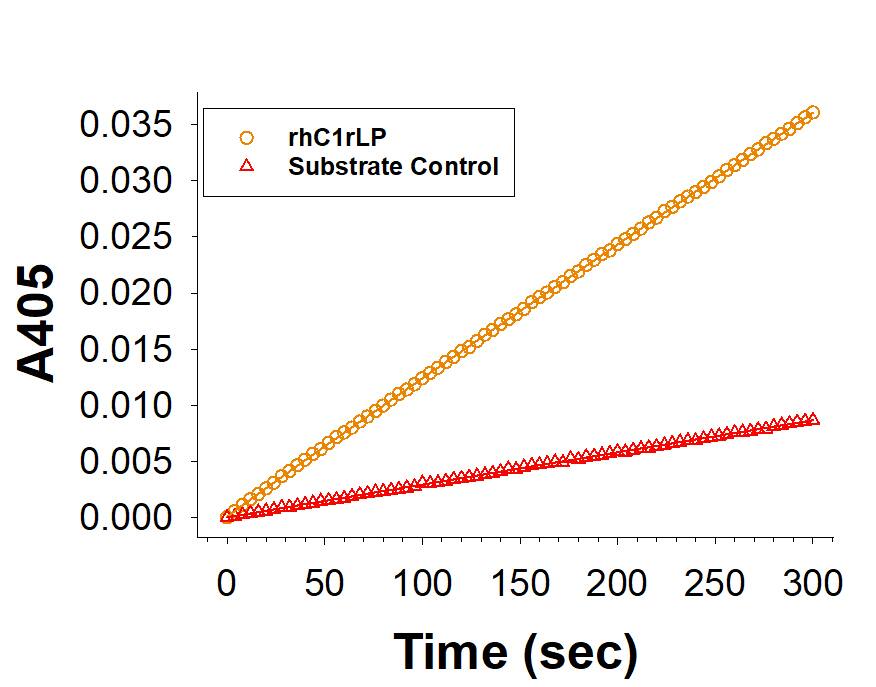Recombinant Human Complement Component C1rLP His Protein, CF
R&D Systems, part of Bio-Techne | Catalog # 11614-CP
HA-tag His-tag

Key Product Details
- R&D Systems CHO-derived Recombinant Human Complement Component C1rLP His Protein (11614-CP)
- Quality control testing to verify active proteins with lot specific assays by in-house scientists
- All R&D Systems proteins are covered with a 100% guarantee
Product Specifications
Source
Chinese Hamster Ovary cell line, CHO-derived human Complement Component C1rLP protein
Cys36-Asp487 with N-terminal HA (YPYDVPDYA) and 6-His tags
Cys36-Asp487 with N-terminal HA (YPYDVPDYA) and 6-His tags
Purity
>95%, by SDS-PAGE visualized with Silver Staining and quantitative densitometry by Coomassie® Blue Staining.
Endotoxin Level
<0.10 EU per 1 μg of the protein by the LAL method.
N-terminal Sequence Analysis
Tyr
Predicted Molecular Mass
52 kDa
SDS-PAGE
70-76 kDa, under reducing conditions
Activity
Measured by its ability to cleave a colorimetric peptide substrate, N-carbobenzyloxy-Gly-Arg-ThioBenzyl ester (Z-GR-SBzl), in the presence of 5,5’Dithio-bis (2-nitrobenzoic acid) (DTNB). Edwards, K.M. et al. (1999) J. Biol. Chem. 274:30468.
The specific activity is >30 pmol/min/μg, as measured under the described conditions.
The specific activity is >30 pmol/min/μg, as measured under the described conditions.
Scientific Data Images for Recombinant Human Complement Component C1rLP His Protein, CF
Recombinant Human Complement Component C1rLP HA-tag His-tag Protein Enzyme Activity.
Recombinant Human Complement Component C1rLP HA-tag His-tag (Catalog # 11614-CP) is measured by its ability to cleave a colorimetric peptide substrate, N-carbobenzyloxy-Gly-Arg-ThioBenzyl ester (Z-GR-SBzl), in the presence of 5,5’Dithio-bis (2-nitrobenzoic acid) (DTNB).Recombinant Human Complement Component C1rLP HA-tag His-tag Protein SDS-PAGE.
2 μg/lane of Recombinant Human Complement Component C1rLP HA-tag His-tag Protein (Catalog # 11614-CP) was resolved with SDS-PAGE under reducing (R) and non-reducing (NR) conditions and visualized by Coomassie® Blue staining, showing bands at 70-76 kDa, under reducing conditions.Formulation, Preparation and Storage
11614-CP
| Formulation | Supplied as a 0.2 μm filtered solution in Tris and NaCl. |
| Shipping | The product is shipped with polar packs. Upon receipt, store it immediately at the temperature recommended below. |
| Stability & Storage | Use a manual defrost freezer and avoid repeated freeze-thaw cycles.
|
Background: Complement Component C1rLP
References
- Lin, N. et al. (2004) Biochem. Biophys. Res. Commun. 321:329.
- Ligoudistianou, C. et al. (2005) Biochem. J. 387:165.
- Wicher, K.B. et al. (2004) Proc. Natl. Acad. Sci. 101:14390.
- Schaer, C.A. et al. (2018) BMC Biotechnol. 18:15.
- Liu, X. et al. (2021) ACS Omega 6:7951.
- Yang, S. et al. (2022) Front. Oncol. 12:934928.
- Chen J. et al. (2023) Aging 15:4444.
- Njoku K. et al. (2023) Br. J. Cancer 128:1723.
- Yoon, H.G. et al. (2023) PLoS One 18:e0295061.
- Beck. H.C. et al. (2024) Int. J. Mol. Sci. 25:2638.
- Liu, G. et al. (2024) Heliyon 11:e32337.
- Zhang, M. et al. (2024) Heliyon 10:e30616.
Long Name
Complement C1r Subcomponent-like Protein
Alternate Names
C1RL, C1RL1, CLSPa
Gene Symbol
C1RL
UniProt
Additional Complement Component C1rLP Products
Product Documents for Recombinant Human Complement Component C1rLP His Protein, CF
Product Specific Notices for Recombinant Human Complement Component C1rLP His Protein, CF
For research use only
